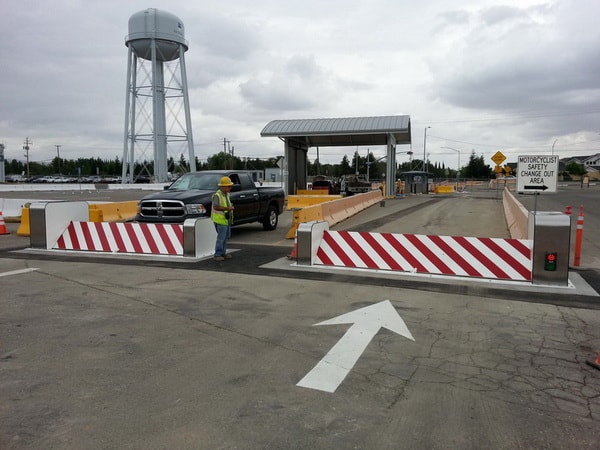The smart Trick of Wedge Barriers That Nobody is Talking About


18 may be done extra quickly, quickly, and price effectively. FIG. In particular personifications, the support 30 might be a steel frame consisting of plates, beam of lights(e. g., I-beams ), and/or other frameworks that are protected within the structure 14, which might be concrete. At the surface area 12, a top side 28 of the support 30 may go to least partly revealed
, therefore enabling the add-on of the obstacle 10 to the support 30. g., threaded holes)in one or more beams or plates of the anchor 30 may be exposed to the surface area 12. In this way, bolts 32 or various other mechanical bolts may be made use of to protect the obstacle 10 to the anchor 30. As the obstacle 10 is installed to the surface 12 of the foundation 14, collection of debris and other product underneath the obstacle might be reduced, and components of the bather 10 may not be subjected to listed below grade environments. As suggested by reference numeral 52, the lifting system 50 consists of parts disposed under the wedge plate 16. The components 52 under the wedge plate 16 might include an electromechanical actuator, a webcam, one or more webcam surfaces, and so forth. Furthermore, the lifting mechanism 50 includes a springtime assembly 54
The spring rod 58 is coupled to a webcam(e. g., cam 80 received FIG. 4) of the lifting device 50. The springs 60 disposed regarding the Full Article springtime pole 58 are held in compression by springtime supports 62, including a fixed springtime assistance 64. That is, the fixed spring support 64 is taken care of loved one to the foundation 14 and the remainder of the bather 10.
What Does Wedge Barriers Do?
g., springtime support 65 )might be repaired to the end of the spring pole 58 to enable compression of the springtimes 60. As the springs 60 are pressed in between the springtime sustains 62, the spring setting up 54 generates a pressure acting on the webcam paired to the springtime rod 58 in an instructions 66. The remaining pressure used to
the cam to deploy the wedge plate 16 may be provided given an electromechanical actuator 84 or other actuator. The springtime setting up 54 and the actuator 84(e. g., electromechanical actuator)might run with each other to translate the web cam and lift the wedge plate 16.
As discussed above, the spring assembly 54 puts in a continuous pressure on the webcam, while the electromechanical actuator may be managed to apply a variable force on the camera, thereby allowing the training and decreasing( i. e., releasing and pulling back )of the wedge plate 16. In specific personifications, the continuous pressure applied by the springtime setting up 54 might be adjustable. g., electromechanical actuator) is handicapped. As will certainly be appreciated, the spring assembly 54 might click resources be covered and secured from particles or other aspects by a cover plate(e. g., cover plate 68 revealed in FIG. 4) that may be considerably flush with the elevated surface area 38 of the foundation 14. As pointed out above, in the deployed position, the wedge plate 16 serves to obstruct access or travel beyond the barrier 10. As an example, the barrier 10(e. g., the wedge plate 16 )might block pedestrians or automobiles from accessing a residential property or path. As discussed over, the obstacle 10 is affixed to the anchor 30 secured within the foundation 14,

front brackets 71. As a result, the linkage settings up 72 might why not try these out pivot and rotate to enable the collapse and extension of the linkage assemblies 72 during retraction and implementation of the bather 10. The linkage assemblies 72 reason movement of the wedge plate 16 to be limited. If a car is traveling towards the released wedge plate 16(e. For instance, in one circumstance, the safety and security legs 86 may be extended duringmaintenance of the barrier 10. When the security legs 86 are released, the safety legs 86 support the weight of the wedge plate 16 against the surface 12. Therefore, the training mechanism 50 may be shut off, serviced, eliminated, changed, and so forth. FIG. 5 is partial viewpoint sight of an embodiment of the surface-mounted wedge-style barrier 10, highlighting the camera 80 and the cam surface areas 82 of the training device 50. Especially, two web cam surfaces 82, which are referred to as lower web cam surfaces 83, are placed listed below the web cam 80. The lower camera surfaces 83 may be repaired to the surface 12 (e. For instance, the reduced web cam surfaces 83 and the placing plate 85 might create a single item that is safeguarded to the anchor 30 by screws or other mechanical bolts. In addition, two camera surfaces 82, which are referred to as upper camera surface areas 87, are placed over the camera 80 and combined to (e. In other personifications, intervening layers or plates might be placed in between the surface area 12 and the lower camera surface areas 83 and/or the wedge plate 16 and the top camera surface areas 87 As mentioned over, the webcam
80 converts along the cam surfaces 82 when the wedge plate 16 is lifted from the retracted placement to the released placement. Furthermore, as discussed over, the springtime setting up 54 (see FIG. 3 )may provide a force acting upon the camera 80 in the instructions 102 via springtime pole 58, which may minimize the force the electromechanical actuator 84 is needed to apply to the webcam 80 in order to activate and lift the wedge plate 16. 1 )to the deployed placement(see FIG. 4). As revealed, the webcam 80 consists of track wheels 104(e. g., rollers), which call and convert along the web cam surface areas 82 during operation.